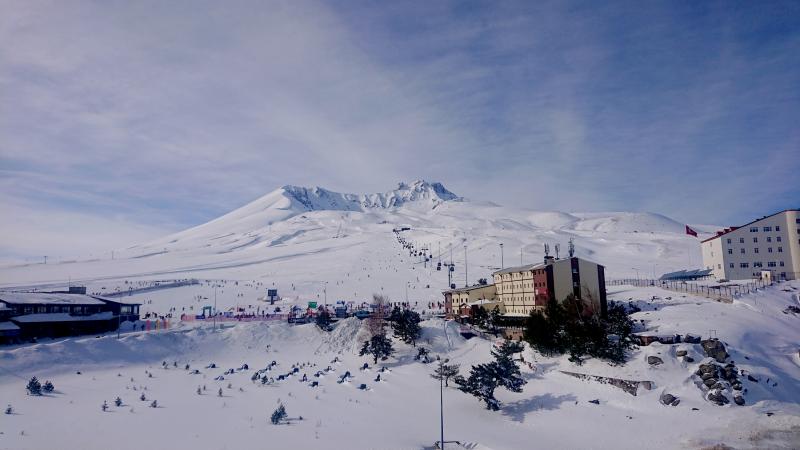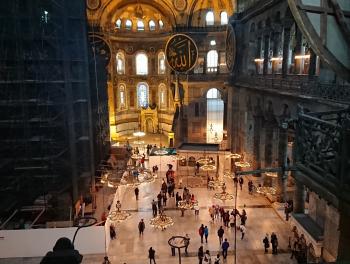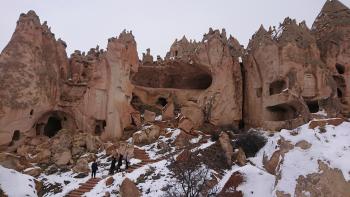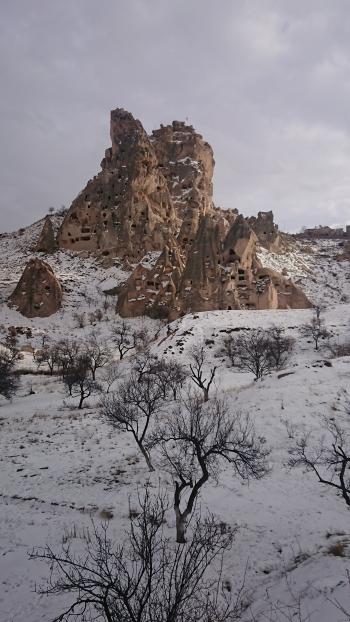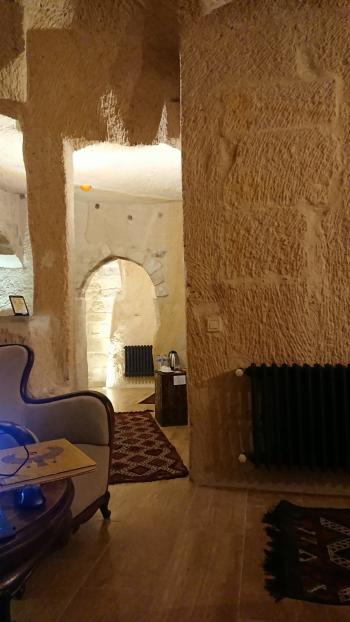Going cold Turkey on a skiing adventure tour
This article appears on page 20 of the June 2019 issue.
It was dawn when the soulful call to prayer woke me up, lifting me from my bed, the ethereal quality of the cries wafting into my window like the scent of a freshly baked cartoon pie. Suddenly, a train clattered by underneath my window, breaking the spell.
I was waking up in Istanbul, near the old city walls of Constantinople. Despite the fact that I had just gotten back to sleep after waking up at 3:30, suffering from the dreaded effects of jet lag — having recently arrived from Los Angeles on a direct Turkish Airlines flight — I don’t think I’ve ever experienced a more beautiful wake-up call.
In Istanbul
Arranged and led by Flo Tours, this January 2019 trip to Turkey, my first, was not to see Istanbul but to ski at Mt. Erciyes (pronounced air-gee-yes), a huge dormant volcano in the Cappadocia region with a newish ski resort. However, a stay in Istanbul is essential to any trip to Turkey.
The highlights of my one day there were definitely Hagia Sofia, the museums at Topkapi Palace and the underground Basilica Cistern. I’ve long wanted to see Hagia Sofia, specifically, and it did not disappoint.
The food in Istanbul was also spectacular, whether eaten at a classy restaurant or an all-night kabob shop.
The Grand Bazaar and the Blue Mosque were less impressive to me, for their own special reasons. I suppose they might be worth a visit to someone who has a few days in the city, but when you’re in a rush, the time it takes to see those two sites might be better spent elsewhere.
I stayed at the Romance Istanbul Hotel (www.romanceistanbulhotel.com), located in the historic Sultanahmet neighborhood, a great location. It was really gorgeous and comfortable, and, best of all, they leave a little tray of pistachio Turkish delight in each guest’s room, which made me fall in love with the place immediately!
The staff was incredibly nice, making packed breakfasts for our tour group on the day we left, which was very necessary because we had to leave the hotel at 4 a.m. in order to make our flight to Kayseri.
I should note that security at the Istanbul Airport (and, indeed, throughout Istanbul) is taken very seriously. Due to the terrible attack on passengers in the check-in section of the airport a few years ago, everyone must now go through a security line before entering the airport in addition to the security line to enter the airside. There were a lot of soldiers carrying big guns, but it was a sort of comfort to know that, since that last attack, there have been no further incidents at the airport.
To the mountain
“We’re now making our final approach into Kayseri. The sky is clear, and the temperature is minus 10.”
Next to me, our guide, Mesut, made a low whistle. “Minus 10; it’s very cold.”
Outside the plane, it was snowball Earth. Through the window, I saw wide, flat-topped hills scooting by under a thick blanket of snow, with nary a tree to be seen. This was a Turkey that was clearly unexpected by many Westerners, according to the most common refrain I heard from people I spoke to about my trip. (“Ski? In Turkey? They have snow in Turkey?”)
A 40-minute bus ride from the airport delivered us to Mt. Erciyes and the quickly growing city of Kayseri, with a population of over one million. The bustling downtown, even on this cold day, was awash with style and culture, and the hotels were sleek and modern.
The resort has some small hotels, too, but we were staying in the Radisson Blu (www.radissonblu.com/en/hotel-kayseri), near the city center. It, and many of the other newer hotels built to accommodate guests of the ski resort, which opened in 2011, have daily transport to and from the mountain in winter.
The mountain itself would be worth seeing even if without its ski slopes. At over 12,850 feet tall, it is the most prominent feature of the high plains that surround it. A wide, decomposing crater rim opens onto a surprisingly gentle and long slope that immediately brings to mind skiing. Kayseri built and operates the ski slopes as a not-for-profit endeavor, and, frankly, it’s shocking to me that it took them until 2011 to realize what perfect conditions they have for the sport.
The slopes
Any and all equipment can be rented, extremely cheaply, at the resort. Skis, snowboards, boots and helmets (required) each cost only TRY50 (near $9), while jackets and pants are even less expensive. (I took my own from home.)
Even better, if you have skis or snowboards at home, a Turkish Airlines executive told us that if Kayseri is your final destination (even if you plan to spend a day or so in Istanbul beforehand), you can check one set of gear for free, there and back. (Check with Turkish Airlines in advance regarding this promotion.)
Skiing is shockingly affordable as well. An all-day ski pass, which allows access to three sets of gondolas (all of which lead to chairlifts for even higher runs) for a total of 32 pistes, or ski runs, costs only TYR70. Even the most bare-bones slope in the US would charge at least twice that, and an Alpine resort runs twice as expensive again.
But don’t think the low cost is indicative of quality; this is a high-class location.
The highest slope reaches all the way to the rim of the volcano’s crater, but it’s only open when conditions allow, which at the time of my visit they did not. The main slopes are guaranteed to be open October through March, since there are snow machines along each in case nature doesn’t cooperate during those dates.
Our itinerary included two days of skiing, and we couldn’t have asked for better days. Each day was bright, clear and still, not to mention warm enough that we were shedding layers while still on the slopes.
Now, I wouldn’t call myself a “skier.” Though I skied often as a youth, it had been 20 years since I strapped on the planks, so I wasn’t exactly confident as I stood in line for the first gondola. But I wanted to know whether skiing was like riding a bike or if I had to start from scratch and take a lesson. (Luckily, if the latter, there were dedicated staff on site for instruction, both group and private.)
When I reached the top, I looked down at the run before me. For an easy slope, it was very imposing.
Though wide and well groomed, it was also very long (over 5,000 feet) and maybe just a little steep from my point of view (an average angle of descent of only about 2 degrees). I stepped into my skis, took a deep breath and pointed myself downhill… and I remembered how to ski! Or, at least, I began to remember.
It took me the entire length of the run, but by the end, I was passably good. So what if 10-year-olds were flying past me like Olympic athletes; as long as I was upright, I was happy, and I managed to be happy most of the time.
Though the skiing was a blast, the best part of the tour was yet to come.
Going caveman
In addition to being at the foot of Erciyes, Kayseri is close to another natural wonder, Cappadocia, most well known for its “fairy chimneys,” pillars of tuff (soft, volcanic rock) that rise from the valley floor thanks to some interesting acts of erosion. (Appropriately, eruptions from Erciyes helped create the tuff found in Cappadocia.)
The tuff is so soft that it is easily excavated, and for hundreds of years the people of the region have carved homes and churches directly into the rock. Throughout Cappadocia, it’s hard to find a single chimney without at least one cell hewn from its slopes.
Not only is the tuff excellent for carving homes out of, it’s also excellent for carving hotels, as we found out at the Acropolis Cave Suite (acropoliscavesuite.com), where we spent the last two days of the trip.
I was lucky to be assigned the Zeus Suite (each room is named after a Greek god), on the ground floor, since being on the ground floor is the only way to be guaranteed a full cave experience. (Upper-floor rooms sometimes have cut-stone walls and ceilings where there is no tuff.)
It was easily the most comfortable room of the entire trip and, wow, so quiet and dark… perhaps a little too quiet and dark.
Cappadocia sites
There is an absolute ton of touring to be done in Cappadocia. Our first stop was an interesting, unnamed area in a small canyon that was really only more significant than others because it had a parking lot. It was also chock-full of tourists. Why? Because it’s free to visit.
Despite the crowds, there actually were some advantages to visiting this particular spot. In particular, there were no restricted paths, so you could walk through the site at your leisure, visiting (or not) any cavern that you might pass.
Thanks to that fact, I and some other members of my group managed to leave the crowds behind and explore an area where we were alone in shin-deep snow among mostly unvisited caves.
Another stop, the Nevs¸ehir Zelve-Pas¸abag˘lar archaeological site, was much more organized and also far less crowded (read ‘it costs money,’ but our fee was included in the tour). Aside from my small group, only one couple was walking the grounds.
At Zelve, we did much more exploring inside the caves, including in a beautifully carved church, but there were also many more caves that were off limits.
Another very impressive collection of caves is at the Göreme Open-Air Museum, where numerous churches with beautiful frescoes abound. This site is particularly popular, though, and the churches are very, very small, so expect to be crushed against a wall at least once.
Speaking of very small, Cappadocia is home to quite a few underground cities. The one we went to was Kaymakli. If you’re at all claustrophobic, the slender winding corridors of this subterranean labyrinth are NOT for you, but if you don’t mind a tight squeeze and a low ceiling, it’s a fascinating jaunt underground.
An unexpected encounter
Cappadocia was also where we witnessed the obligatory craft demonstrations.
Actually, the rug-making demonstration, at a workshop where women are taught traditional rug-making techniques, including dyeing and silk harvesting, was really entertaining… almost enough to convince me to leave with a rug. (I didn’t.) And, thankfully, the gemstone and jewelry demonstration was short.
It was the ceramics demonstration, however, that I really want to talk about. The demonstration, itself, was nothing spectacular. As we sat and watched the master potter, Galip Körükçü, make a teapot on a wheel, my eyes wandered around his studio, suddenly spying a few strands of hair hanging from the ceiling.
I perked up. “It’s the hair guy!” I thought to myself.
Let’s rewind for a moment. About two decades ago I was watching television. I don’t remember the show — a news show, probably — but they were talking about a new world’s record: the record for the largest collection of hair. And they had an interview with the collector, none other than Galip.
It was a strange and bewildering collection. Galip collected only women’s hair, keeping their locks in his clay-drying caves. The caves looked like they were covered in yak fur, but really they were covered in the hair of more than 16,000 women, each lock with the original owner’s name and contact information!
“Wow, that’s pretty gross,” I thought back then, and then never thought about it again, until I suddenly found myself in the man’s home.
I poked the woman sitting next to me and whispered, “He’s going to ask for some of your hair.” Her eyes got really big as she mouthed “Why?” at me. “’Cause that’s what he does,” I said.
After finishing his pot, Galip said, “Do you want to see my hair museum?” and he told his tale. (It turned out that one of the other members of our group also knew who he was and shared it with those around her, so really no one was surprised.)
Galip’s current workshop is actually not the home of his hair collection. That is located a short drive away in the town of Avanos, where he used to produce ceramics until the hair took up too much space. Now it’s solely the Avanos Hair Museum.
The inside is exactly as scary as you would think, especially for someone as tall as me (6'3") — who had to constantly bat hair away from my face. It’s hard to describe, exactly, what a series of caves covered in the hair of more than 16,000 women looks like, but whatever you’re imagining, you’re not even close!
We wandered the museum for a bit, taking it all in, before watching three of the women in our group sacrifice a swatch of hair for his walls.
If you’re wondering if there is a point to all this, twice a year, six swatches of hair from the collection are chosen at random, and Galip then gives the women to whom they belonged a one-week, all-expenses-paid trip to Cappadocia, during which he teaches them his ceramics techniques. If nothing else, each person who donates hair gets to be included in a world-record project.
Final thoughts
There’s so much more to say about Turkey that it would take three or four articles to tell it all, so let me focus on my favorite parts.
The food in Turkey is fantastic. At the beginning of the trip, a friend emailed me and asked, “How’s the food?” My best answer was, “A lot of meat and a LOT of sugar,” and that remained true to the end.
Whether you’re in one of the many inexpensive kabob shops in Istanbul, a fancier kebap restaurant in Kayseri (where they might serve you a “popular” local drink that tastes like someone put soap in a V8) or a cave restaurant in Cappadocia, where you can eat a chicken stew directly out of the earthenware jar it was cooked in over an open flame, the food will always be amazing, there will always be too much of it, and at the end of the meal, you will be drowning in desserts.
Another thing that will always be is the presence of tea. Tea is paramount in Turkey, and you’re free to take it with no sugar, some sugar or, as tradition requires, all the sugar.
Turkish coffee, surprisingly, was not that common. You can get it with your breakfast at the hotel if you ask nicely, and they will act like it is a huge chore (because it is). Most coffee I encountered was pretty weak and often instant, so I stuck with tea.
Even better than the food were the people.
In North America, many live in a bit of a bubble when it comes to the Middle East. Our news tells us about unrest in the Kurdish areas and ISIS incursions on the border of Syria. We also hear a lot of things about the government, particularly Turkey’s president, Erdoğan. From what you might glean from Western sources, the country of Turkey is increasingly orthodox and authoritarian, and I certainly think Erdoğanmay encourage that image. But, like most things on this planet, the truth on the ground is far different from what’s expected.
All the Turks we met were incredibly joyful, expressive, hospitable and tolerant people. People like the city official in Kayseri, who told me, unprompted and without even knowing that I was Jewish, that he was hoping someone would build a synagogue in the city, or the woman at the café who responded to our inability to communicate with her with what can only be described as “teenaged exasperation” but still gave us fantastic service and refused a tip despite all the trouble we put her through.
The people we met were excited to see us not just because North American and Western European visitors don’t make it to central Turkey very often but also because they knew they could speak freely with us.
Right now, in Turkey, expressing any antigovernment sentiments can cause trouble. Journalists are regularly detained in the country for reporting on social issues that the government disagrees with. Locals probably won’t be arrested for not supporting Erdoğan, but they could find that they no longer have jobs, or officials might look a little more closely at their activities.
But that makes visiting Turkey even more important and pressing. The Turkish government may be moving down a path of increasing isolation, but the Turkish people, who have for millennia been at the crossroads of the world, have a deep and abiding desire to meet and welcome all kinds of people.
After my very fast week in Turkey, I, for one, believe I will always feel welcome there.
Dan Barr was a guest of Flo Tours (Lake Mary, FL; 800/417-3880, www.flotours.com). To book a 6-day, 5-night Mt. Erciyes ski trip, which includes two days of skiing plus visits to Istanbul and Cappadocia, visit www.visiterciyes.com or call Flo Tours. The price of $695-$895 per person, double occupancy, land only, depends on ski dates, with weekend skiing more expensive.

